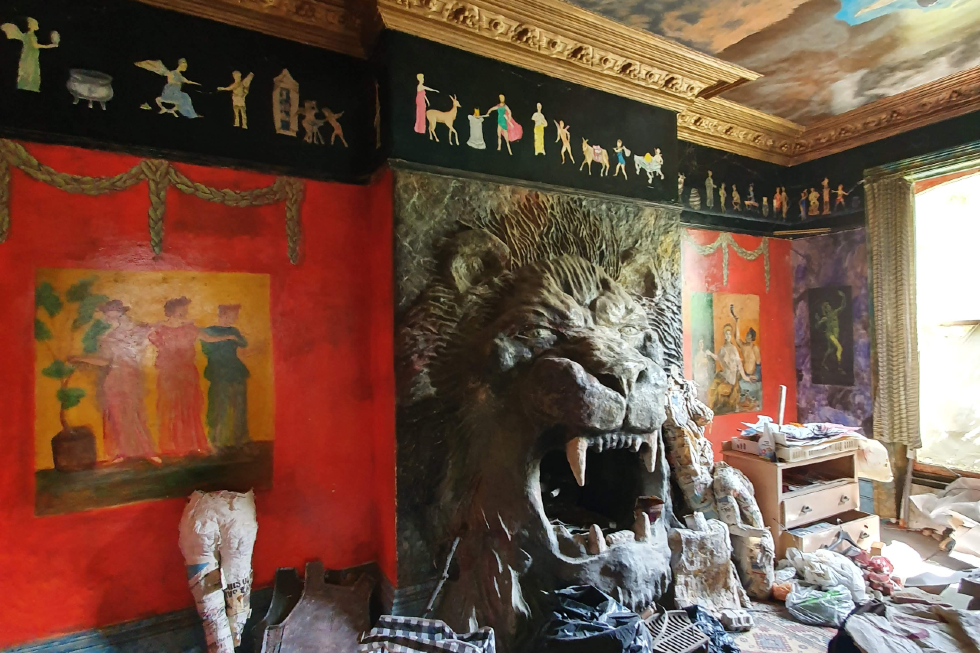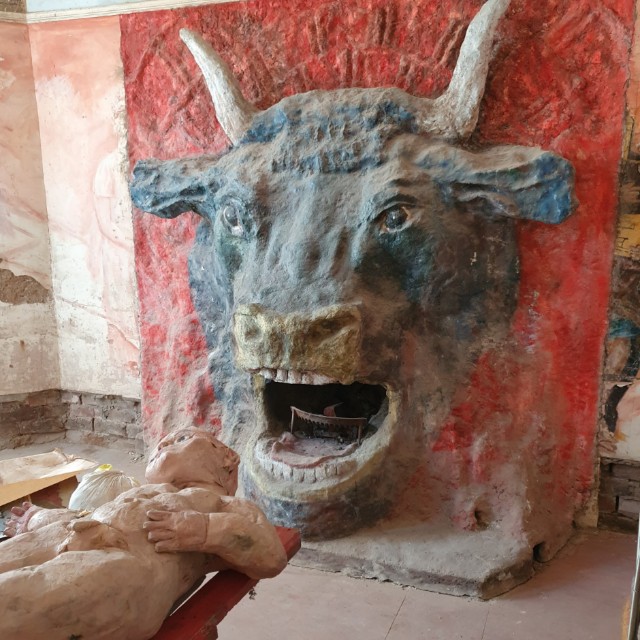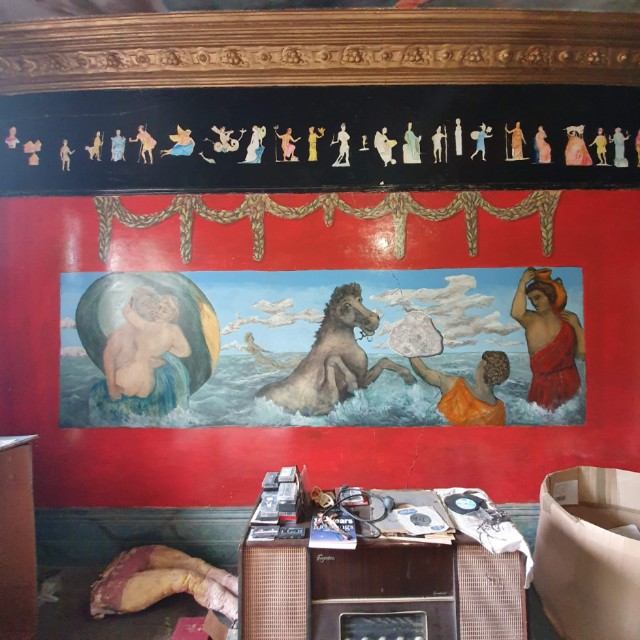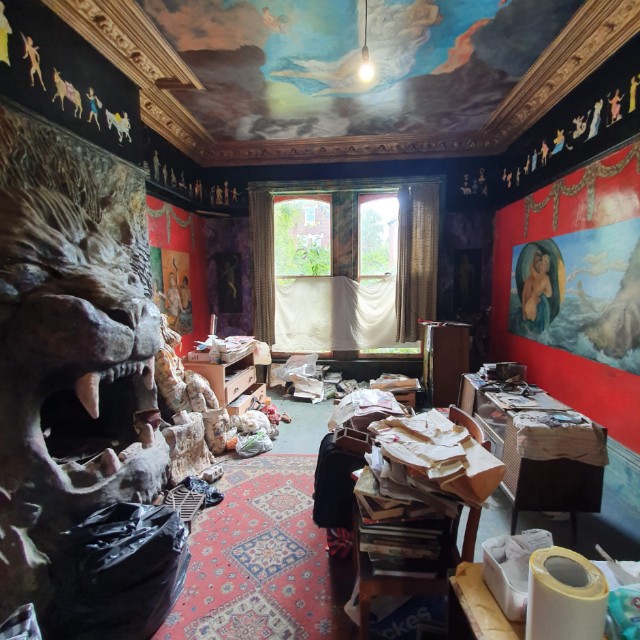“It’s Worth Fighting For” – Denise Courcoux Takes A Trip To Ron’s Place

Victorian red-brick semi or visionary environment? Denise Courcoux finds Ron’s Place, in Birkenhead, is both…
The Victorian red-brick semi appears unremarkable at first glance. Set back from a side road in Birkenhead, and split up into flats, weeds in the front yard and a peeling front door point to commonplace disrepair. A closer look, however, reveals a very particular kind of attention has been paid to this house, a world away from everyday maintenance such as weeding and weatherproofing. The boxy plastic cable trunking that runs up the front of the building has been painted with mortar lines and daubed with textured brown paint, to match the brickwork either side of it. A pleasingly prosaic trompe l’oeil hinting at what lies behind the battered front door.
This is Ron’s Place, the former home of one Ron Gittins. Its interior is an extraordinary example of what might, in certain circles, be categorised as a ‘large scale visionary environment’; the ground-floor flat is a work of art, inhabited for more than thirty years by its creator until he died in September 2019, shortly before his 80th birthday. Ron had been cautious of accommodating visitors, wary of his landlord discovering his unauthorised and defiantly unorthodox decorating, so few had seen the extent of his handiwork until relatives entered the flat after his passing. Awaiting them was a profusion of art: paintings, sculpture and drawings cover pretty much every available surface inside Ron’s former home, including the walls, ceilings, and floors.
I visited during a brief window last year while coronavirus restrictions allowed, with Ron’s niece Jan Williams, and found walking around the rooms in which he lived both a disconcerting and astonishing experience. The Egyptian death god Anubis greets visitors in the gold and blue hallway, painted with hieroglyphs, pharaohs, and mythological scenes, all rendered in bold, confident brushstrokes. Through the doorway to the right is a Roman-themed living room hosting one of the most impressive individual artworks in the flat: a concrete lion’s head that dominates the chimney breast, its mane rippling out in waves, and fangs bared around the cavity of the fireplace. Ancient legends are played out in frescoed scenes around the walls, and up onto the baroque-inspired ceiling, where clouds break to reveal a centurion, posing triumphantly.

As Jan, herself an artist and co-founder of The Caravan Gallery, guided me around her late uncle’s home, she talked about the recurring theme of power that was a preoccupation of Ron’s. It’s there in the lion’s counterpart, an enormous bull’s head fireplace in the adjacent front room, and in the portraits of richly-uniformed military commanders lining the walls of the back room. What kind of person is driven to transform their home – an ordinary rented flat in suburban Merseyside – so dramatically? People and their lives are knotty, complicated things, and Ron was certainly a complex person, who struggled with mental health throughout adulthood. Jan remembers him as a difficult man; well-loved by family and friends, but with a tendency to be argumentative and contrary. He held outdated views on women and their place in society, for example, reflected in some of the artworks in his flat; the portrait of a coquettish girl in a negligée, and a comically pneumatic model of Cleopatra, are pure male fantasy.
A well-known, instantly recognisable figure in Birkenhead, Ron had taken to wheeling his Cleopatra around town in a pram. He enjoyed dressing up and often adopted a costumed ‘wandering minstrel’ character that could often be found serenading customers in local shops; Timpson’s key cutters was a favourite haunt of his. In contrast to the grand, romanticised historic themes that obsessed Ron, he lived in relative poverty, cooking tinned food on a camping stove, and sleeping in his hallway toward the end of his life due to the lack of usable space available in the flat. And, unwilling to share the extent of his ill health with others, he slipped through the cracks of professional intervention.

Alongside his artworks, Ron’s home is full of his possessions, which allude to some of the details of his life. Outside of lockdowns, Jan, helped by friends and volunteers, is undertaking the painstaking process of sifting through the mountains of hoarded material. There are decades of notes, lists, preparatory sketches, and correspondence (Ron was a serial complainer) to be retrieved from among the takeaway flyers and newspapers. I unfolded a brittle letter at the top of one pile to discover a British Broadcasting Corporation header, beneath which a typewritten note advises Ron that, as per their rules, they are unable to return his entry to the ‘Let’s Paint in Oils’ competition. It’s dated 1954, when Ron would have been just 15. Opposite the paper mountain, on top of a dark wooden wardrobe, is a row of disembodied papier-mâché heads in various stages of completion. A glossy copper-painted bust of Alexander the Great still bears a tag from its entry to the Royal Academy Summer Exhibition of 1998.
Though since its posthumous discovery his work has been labelled Outsider Art – a problematic catch-all term due to its application by the art world’s ‘insiders’ – it appears Ron didn’t view himself as operating outside the realms of establishments like the BBC and the Royal Academy, despite the secretive nature of his creative process. He did, in fact, have some formal art training, having attended Laird School of Art in Birkenhead for a period. The artworks and the many works in progress strewn throughout his home have been made using mostly cheap or freely found materials, showing great resourcefulness. They employ a wide range of media including papier mâché and concrete sculptures, stitched textile work, painting and drawings. The variety of styles points to a desire to experiment; while the back room’s ceiling painting of Roman figures flanking a painterly sky is uniquely loose and expressionistic, in the living room he has created a convincing trompe l’oeil of a section of lost plaster in the middle of the wall.

Since its discovery there has been much interest in Ron’s Place, notably from filmmaker Martin Wallace and musician Jarvis Cocker, who collaborated on the TV series Journeys Into the Outside (1998), which explored alternative artistic practices. The Caravan Gallery has recently launched a Patreon to raise essential funds, not only secure and preserve Ron’s Place as a unique immersive artwork, but also to carry out essential maintenance with a view to creating a space to inspire artists and the local community. How would Ron have felt about his long-hidden creation being made public? Jan is in no doubt that he would have been delighted at the prospect; he thrived on attention, and during his life had often attempted to get his art seen in other ways that wouldn’t have risked his eviction.
Artistic fantasy worlds such as Ron’s Place usually lack any protection, making them particularly liable to permanent loss. With rent to be covered in the short term at least, masses of belongings to sort through, and a poor state of repair throughout the flat due to the prolonged lack of maintenance, Jan and her team face a sizeable task. Its preservation is certainly worth fighting for though; the curiosity and delight these environments, hidden in suburbia, elicit when they are discovered, show their capacity to capture imaginations in a unique way.
Denise Courcoux
For more on Ron’s Place, visit the website
All images courtesy Denise Courcoux





